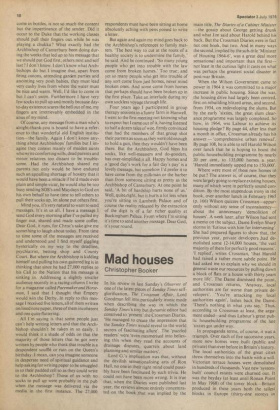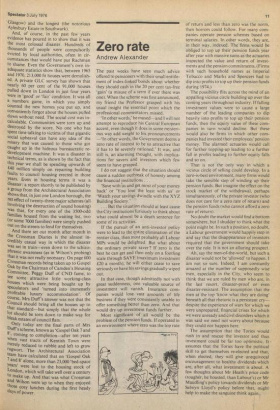Mad houses
Christopher Booker In his review in last Sunday's Observer of one of the latest pieces of Sunday Times selfglorification, The Crossman Affair, Lord Goodman fell into particularly ironic mode when describing the way in which the Sunday Times's tiny but dynamic editor had contrived to 'present' the Crossman Diaries. 'He managed to create the impression that the Sunday Times would reveal to the world secrets of fascinating allure'. The 'puzzled readers' were 'even mesmerised into believing this when they read the accounts of drainage disputes, quarrels about land planning and similar matters'.
Lord G.'s implication was that, without the devilish sensationalising arts of Ron Hall, no one in their right mind could possibly have been fascinated by such trivia. He could not have been more wrong. It is true that, when the Diaries were published last year, the reviews almost entirely concentrated on the book that was implied by the main title, The Diaries of a Cabinet Minister —the gossip about George getting drunk and what Jim said about Harold behind his back. But the Crossman Diaries were in fact not one book, but two. And in many ways the second, implied by the sub-title 'Minister of Housing 1964-6', was a great deal more sensational and important than the first— not least in the curious light it casts on what was perhaps the greatest social disaster in post-war Britain.
When the Wilson Government came to power in 1964 it was committed to a major increase in public housing. Since the war, the housing drive had largely been centred, first on rebuilding blitzed areas, and second, from 1954, on redeveloping the slums. But by the early 'sixties, the great slum clearance programme was largely completed. So how, in 1964, wss Labour to achieve its housing pledge? By page 44, after less than a month in office, Crossman already has his answer — 'comprehensive urban renewal'. By page 108, he is able to tell Harold Wilson over lunch that he is hoping to boost the public housebuilding programme by nearly 20 per cent, to 135,000 homes a year. 'Harold immediately upped me to 150,000'.
Where were most of these new homes to be put ? The answer is, of course, that they were largely going to replace existing houses, many of which were in perfectly sound condition. By the most stupendous irony in the book, over another lunch in February 1965 (p. 166) Wilson quizzes Crossman—apparently without any sense of inconsistency— about the unnecessary 'demolition of houses'. A week later, after Wilson had sent a memo on the subject, Dame Evelyn Sharp storms in 'furious with him for intervening'. She had prepared figures to show that, the previous year, private developers ,had demolished some 12-14,000 houses, 'the vast majority of them for perfectly good reasons'. 'I replied', writes Crossman, 'that Harold had raised a rather more subtle point. He had asked me to explain why we should in general waste our resources by pulling down a block of flats or a house with thirty years more life'. The Dame dismissed the point, and Crossman returns, 'Anyway, local authorities are far worse than private developers'. 'You're attacking my local authorities again', lashes back the Dame. 'There's nothing in what you say.' Thus, according to Crossman at least, the argument ended—and thus Labour's great public housebuilding programme of the late 'sixties got under way.
In propaganda terms, of course, it was a triumph. Over each of five successive years, more new homes were built (public and private) than ever before in Britain's history. The local authorities of the great cities threw themselves into the battle with a will. Victorian terrace houses were demolished in hundreds of thousands. Vast new 'systembuilt' council estates were churned out. It was the heyday (at least until Ronan Point in May 1968) of the tower block—Britain produced in these years both the tallest blocks in Europe (thirty-one storeys in Glasgow) and the longest (the notorious Aylesbury Estate in Southwark).
And, of course, in the past few years evidence has poured in to show that it was the most colossal disaster. Hundreds of thousands of people were compulsorily evicted by local authorities, often in circumstances that would have put Rachman to shame. Even the Government's own inadequate statistics show that, between 1965 and 1970, 213,000 fit houses were demolished. A private GLC survey has shown that nearly 60 per cent of the 91,000 houses pulled down in London in just four years were in 'good' or 'fair' condition. It was all a numbers game, in which you simply counted the new homes you put up, and conveniently forgot about the houses pulled down without need. The social cost was incalculable. Communities were torn up and destroyed by the score. No one who has spent time talking to victims of that gigantic social upheaval can have any idea of the misery that was caused to those who got caught up in the hideous bureaucratic re development machine. It was a disaster in technical terms, as is shown by the fact that this year we shall be spending upwards of £40 million simply on repairing building faults to council housing erected in those Years. Even in housing terms it was a disaster : a report shortly to be published by a group from the Architectural Association Shows that, in just one London borough, the net effect of twenty-three major schemes (all Involving the destruction of sound housing) Was that, for every one of the 3500-odd families housed from the waiting list, two (or some 7000 families) were simply pushed out on the streets to fend for themselves.
And there set out month after month in the Crossman Diaries is the almost in credibly casual way in which the disaster was set in train—even down to the schizophrenic awareness (as in Wilson's probing) that it was not really necessary. On page 600 Crossman records being taken up to Gospel Oak by the Chairman of Camden's Housing Committee, Peggy Duff of CND fame, to see some attractive little working-class houses which were being bought up by sPeculators and 'turned into immensely Profitable luxury accommodation'. Of course, Mrs Duff's answer was not that the Council should bring all the houses up to that standard—but simply that the whole lot should be torn down to make way for bleak estates of council flats.
Only today are the final parts of Mrs Duff's scheme, known as 'Gospel Oak 7 and 8, coming to completion—after ten years When vast tracts of Kentish Town were merely reduced to rubble and left to grow ragwort. The Architectural Association team have calculated that on 'Gospel Oak 7 and 8' alone, more than 23,000 'bed-space Years' were lost to the housing stock of London, which will take well over a century to make up. And that was what Crossman and Wilson were up to when they enjoyed those cosy lunches during the first heady days of power.



































 Previous page
Previous page